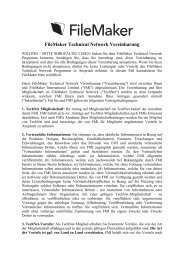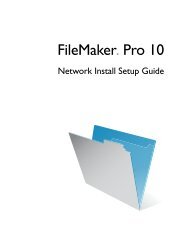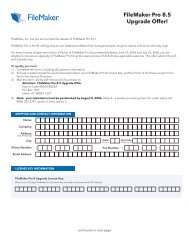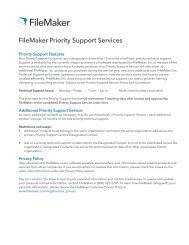FileMaker Server Guide to Updating Plug-ins
FileMaker Server Guide to Updating Plug-ins
FileMaker Server Guide to Updating Plug-ins
Create successful ePaper yourself
Turn your PDF publications into a flip-book with our unique Google optimized e-Paper software.
How au<strong>to</strong>matic downloading works<br />
Au<strong>to</strong> Update ensures clients have current plug-<strong>ins</strong> by addressing two situations:<br />
Chapter 1 | How au<strong>to</strong>matic downloading works 7<br />
1 The client is opening your database for the first time, and the plug-in that the database requires doesn’t<br />
exist on the client computer.<br />
1 The client has opened your database previously, but has an outdated version of a required plug-in and<br />
needs an update.<br />
The following sections describe the general sequence of events when a plug-in is missing from or out of date<br />
on the client computer.<br />
When the required plug-in is missing from the client computer<br />
The client starts <strong>FileMaker</strong> Pro and attempts <strong>to</strong> open your database hosted by <strong>FileMaker</strong> <strong>Server</strong>. Scripts,<br />
which you have defined in your database, run the external functions for Au<strong>to</strong> Update in the following order:<br />
1. The external function FMSAUC_Version runs, returning the name and version of the Au<strong>to</strong> Update plugin<br />
available on the <strong>FileMaker</strong> Pro client computer. If plug-in information isn’t returned, it is assumed that<br />
the plug-in is missing from or disabled on the client computer.<br />
2. The external function Your<strong>Plug</strong>In_Version runs, returning the name and version of the client computer<br />
plug-in that will be used in the database. If plug-in version information is not returned, it is assumed that<br />
the plug-in is missing or disabled on the client computer.<br />
3. The external function FMSAUC_Find<strong>Plug</strong>In runs, searching the server Au<strong>to</strong>Update folder and the server<br />
default database folder for the plug-in versions. The function returns a string, delimited by spaces, that<br />
lists all available plug-in versions.<br />
4. The string is searched for the version returned by the Your<strong>Plug</strong>In_Version function. If no version<br />
information is returned by Your<strong>Plug</strong>In_Version, it is probably because the version on the server is greater<br />
than the version of the plug-in on the client computer.<br />
5. If the option <strong>to</strong> return the latest plug-in version is enabled, the external function FMSAUC_Update<strong>Plug</strong>In<br />
places the required plug-in in<strong>to</strong> the current user’s <strong>FileMaker</strong> Extensions folder as follows:<br />
On this operating<br />
system: The plug-in is s<strong>to</strong>red in this folder:<br />
Windows XP C:\Documents and Settings\user_name\Local Settings\Application Data\<strong>FileMaker</strong>\Extensions\<br />
Windows Vista C:\users\user_name\AppData\Local\<strong>FileMaker</strong>\Extensions\<br />
Mac OS X Macin<strong>to</strong>sh HD/Users/user_name/Library/Application Support/<strong>FileMaker</strong>/Extensions/<br />
When starting, <strong>FileMaker</strong> Pro first loads the plug-<strong>ins</strong> s<strong>to</strong>red in the current user’s <strong>FileMaker</strong> Extensions<br />
folder. If a particular plug-in is not found in that folder, <strong>FileMaker</strong> Pro searches for that plug-in in the<br />
Extensions folder for the <strong>FileMaker</strong> Pro application.
















